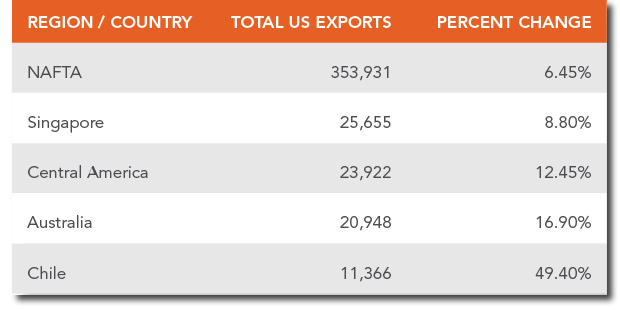5 Best Practices for Leveraging Trade Agreements to Reduce Landed Costs

It’s no secret that free trade agreements (FTAs) offer a significant opportunity for duty savings, FTAs make it easier for companies to reduce the landed cost of sourced products, and improve profit margins on exported products.
Despite these benefits, many companies are not taking advantage of trade agreements due to the perceived complexities and costs associated with administering them.
For example, companies need country of origin tracking, special program or trade program indicators, tools to solicit supplier collaboration, and a means to ensure regulatory compliance to prevent fines and delays.
Luckily, there are strategies companies can use to simplify the trade agreement management process. Here are 5 best practices that will allow your company to fully take advantage of FTAs:
1. Implement a Supplier Management Program
To effectively manage free trade agreements, you need to have a supplier management program to collect information critical to supporting a preferential status claim. Most FTAs require a certificate of origin as well as a trade program certificate to prove a claim.
To consistently collect this information, there are three important steps to establishing a supplier management program:
-
Establish a communication channel by which suppliers can expect to receive requests and information. Identify who within your supplier’s organization will be responsible for sending the information.
Explain the importance of knowing the country of origin for the parts as well as the trade program benefits.
- Explain how you intend to gather this information from the supplier and in what format it should be submitted.
2. Achieve Multi-sourcing Data Visibility
An effective supplier management program requires systems support to provide multi-sourcing data visibility. When sourcing from multiple suppliers, there are often situations of multiple countries of origin as well as multiple FTA opportunities depending on the source country for the part.
Data visibility can be achieved by creating a representation of your purchased part information. GTM solutions allow you to keep separate information for each part with respect to an individual supplier.
This information is often constructed from purchase orders and can automatically build the relationships between parts and suppliers. With this baseline, you know all parts by supplier as well as the applicable FTAs and can easily create supplier solicitation campaigns and build a request without rekeying any part information. This process is explored in the next best practice.
Leveraging Trade Agreements to Achieve the Next Level of Global Sourcing Savings
The United States is party to many bilateral and multi-lateral trade agreements. Countries with which the US has active trade agreements include: Australia, Bahrain, Chile, Israel, Jordan, Morocco, Peru, Oman, Singapore, Canada and Mexico.
The North American Free Trade Agreement (NAFTA) has seen increased trade volume of close to 200% since its inception in 1993. To put this into perspective, US exports to the NAFTA partners grew at a rate of 133% while its exports to the rest of the world grew only 77%. Similarly, from 2007 – 2008, trade between the US and many of its FTA partners grew substantially noted in the following table:
Savvy companies are manufacturing saleable goods in a particular region or country, and sourcing their components from countries encompassed within an existing FTA. Likewise, major duty savings can be realized by taking advantage of sourcing and distribution channels that already exist.
For example, many of the largest global companies today have aligned their supply chain and manufacturing operations to specifically target the benefit of NAFTA when serving the US and Canadian markets. In this way they can save hundreds of thousands, if not millions of dollars per year in duty savings.
3. Automate the Supplier Solicitation Process
The key to managing a portfolio of trade agreements is to automate the process of soliciting suppliers for all required FTA information to establish compliance with the program. Look for a GTM solution with campaign management capabilities, which allows you to create mass solicitations using purchased part data for many suppliers at once and for any given trade program. In this way, you can solicit hundreds of suppliers in just a few minutes.
4. Automate the Qualification Process for Multiple FTAs
Now that you have collected certificates from all of your suppliers for the affected purchase parts, the final step is to systematically qualify bills of material using the appropriate rules of origin. This will determine if the product qualifies for preferential treatment. Rules of origin for each of your targeted free trade agreements must be available for qualification algorithms to test the product bill of material (BOM) for each end-item. Rules of origin should be able to be loaded into your system without having to take a software upgrade. In this way, you can flexibly add new FTAs to your portfolio and avoid the cost of upgrading and re-implementing software.
5. Add New FTAs by Building on Your Base Portfolio
Companies can rapidly support new trade programs by building on the existing infrastructure and business data of available FTAs in the base portfolio. Often, the only primary difference between FTAs is the rule of origin content. The BOM integration and supporting business data can be fully reused.
Want to learn even more about taking advantage of FTAs?
Related: What Are Companies Looking for in GTM in 2016?

Article Topics
Amber Road News & Resources
Logistics Platforms: Ways Companies Can Win In the Digital Era Ethical Sourcing – The Business Imperative (and Advantage) How Rules of Origin Really Do Make a Difference for Sourcing Practices E2open’s acquisition of Amber Road is a done deal E2open Completes Acquisition of Amber Road Bridging the Data Gap Between Sourcing and Logistics Medical Technologies Company Remedies Complex Compliance Operations More Amber RoadLatest in Supply Chain
Ask an Expert: How Shippers Can Prep for Hurricane Season Apple Accused of Multiple Human Rights Violations South Korea Finally Overtakes China in Goods Exported to U.S. UPS Struggles in First Quarter With Steep Earnings Decline How Supply Chains Are Solving Severe Workplace Shortages SAP Unveils New AI-Driven Supply Chain Innovations How Much Extra Will Consumers Pay for Sustainable Packaging? More Supply Chain














